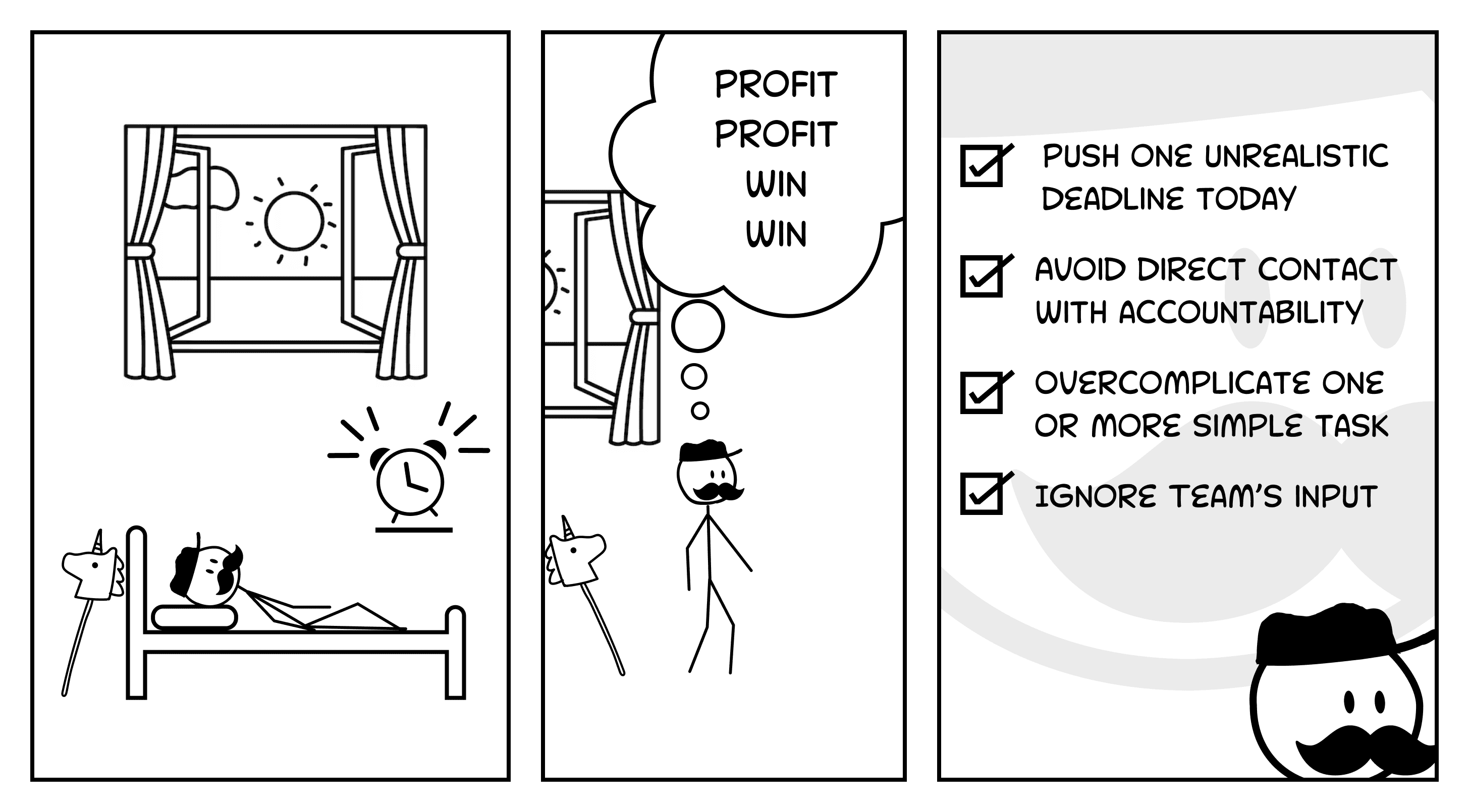
Geo
November 22, 2024
The One With The Agile Micromanager
A Paradoxical Creature
Introducing the Agile Micromanager
Turns daily standups into status interrogations rather than team check-ins.
Pushes unrealistic deadlines while ignoring team input.
Obsesses over velocity metrics like it’s a competition, not a guide.
Overcomplicates simple tasks and dictate processes, stifling creativity.
Ignores accountability, treating Agile as a buzzword instead of a mindset.
The Agile Micromanager: Preaching Agile, Practicing Control
Agile was meant to revolutionize the way teams work—focusing on collaboration, trust, and autonomy. But lurking in some organizations is a paradoxical figure: the Agile Micromanager. This leader enthusiastically touts Agile principles while behaving in ways that undermine them, creating an environment that’s anything but agile.
From turning standups into status interrogations to obsessing over velocity as if it's a leaderboard, the Agile Micromanager fosters frustration, inefficiency, and a lack of trust. Let’s dive into the traits of this leadership style, the damage it causes, and what teams can do to reclaim their autonomy and bring true agility back to their workflows.
7 Key Traits of an Agile Micromanager
Scrum Master or Manager in Disguise
Agile ceremonies, like retrospectives and planning meetings, are intended to empower teams. But for an Agile Micromanager, these ceremonies become tools to enforce personal agendas or micro-level oversight. Instead of enabling team-driven solutions, they turn standups into status updates and step into every decision-making process.
Over-Involvement in Details
Micromanagers can't let go of control. They interrupt work to "check-in," provide unsolicited corrections, and insist on controlling every task's progress. This disrupts team flow, stifles creativity, and shifts focus from solving problems to appeasing their oversight.
Obsession with Velocity
For the Agile Micromanager, velocity is a weapon rather than a guide. They pressure teams to hit arbitrary numbers without considering the quality of work or the long-term impact of technical debt and burnout.
Ignoring Team Autonomy
Agile thrives on self-organizing teams, but the micromanager doesn't trust the process. They dictate how tasks should be executed, reassign work arbitrarily, and undermine team ownership, leaving members feeling powerless.
Focus Solely on Outputs
Delivering value is critical in Agile, but focusing only on outputs while ignoring experimentation, innovation, and technical debt erodes team creativity. Agile Micromanagers cut corners on essential ceremonies like retrospectives, prioritizing speed over quality.
Rigid Adherence to Processes
Agile frameworks like Scrum or Kanban are designed to be adaptable, but micromanagers treat them as rigid rulebooks. They enforce every ceremony and artifact regardless of whether they add value, bogging the team down with unnecessary bureaucracy.
Fails to Act on Feedback
Retrospectives may highlight the need for change, but Agile Micromanagers often ignore or dismiss feedback that doesn’t align with their vision. Worse, they avoid accountability for their own actions while holding the team to impossibly high standards.
The Effects of an Agile Micromanager
The ripple effects of micromanagement are both immediate and long-term:
Team Frustration and Burnout: Constant scrutiny demoralizes teams and saps motivation, leaving them unable to perform at their best.
Decreased Creativity and Innovation: Fear of making mistakes or deviating from the micromanager’s expectations stifles risk-taking and out-of-the-box thinking.
Breakdown of Agile Values: Transparency, trust, and collaboration—the backbone of Agile—are eroded under micromanagement.
Inefficiency: Frequent interruptions, top-down directives, and unnecessary complexity derail focus and slow progress.
7 Things Teams Can Do About an Agile Micromanager
While dealing with an Agile Micromanager can be challenging, the steps teams can take to improve the situation largely depend on the culture within their organization. A culture that values openness, collaboration, and constructive feedback will make it easier to address micromanagement and foster change. However, in more rigid or hierarchical environments, teams may need to adapt their approach and tread more cautiously.
Educate on Agile Principles
Micromanagers may not fully understand Agile’s emphasis on team autonomy. Share resources, suggest Agile workshops, or even involve an Agile coach to help reframe their understanding.
Focus on Transparency
Provide visibility into the team’s progress using tools like Jira or Trello. When the micromanager has access to clear, regular updates, their need for constant check-ins may diminish.
Establish Boundaries
Push back politely but firmly when the micromanager oversteps. Agree with the leader what decisions are within your purview and where leadership input is appropriate. A clear working agreement is useful written guide.
Use Retrospectives Constructively
Bring up micromanagement as an area of improvement and experimentation during retrospectives, framing it as an opportunity for the team to improve collaboration and efficiency. Propose small, actionable changes and observe the outcomes together.
Speak as a Unified Team
Micromanagers are less likely to dismiss collective feedback. Align as a team and present concerns collaboratively, emphasizing how greater autonomy would benefit both the team and the project.
Highlight Outcomes, Not Outputs
Shift the focus from deliverables and velocity to meaningful results, such as business value delivered or customer satisfaction. This can help redirect the micromanager’s priorities toward what truly matters. Consistently deliver quality work and meet commitments to demonstrate the team’s reliability. Over time, this may reduce the micromanager’s need for control.
Involve an Agile Coach or Mediator
An Agile coach can provide neutral, expert guidance to address micromanagement behaviors and reestablish trust and autonomy within the team.
Lead Teams to Thrive
The Agile Micromanager undermines the very principles they claim to support. However, with the right strategies, teams can navigate this challenge and foster an environment that prioritizes collaboration, trust, and innovation. By using their collective voice, teams can navigate this paradox and lead the way toward meaningful change.
True Agile leadership is about enabling teams to thrive, not controlling them into submission. By addressing micromanagement head-on and reinforcing Agile values, teams can move past the frustrations and reclaim the autonomy needed to deliver meaningful, impactful work.



